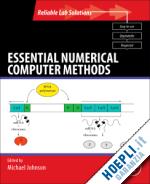

Questo prodotto usufruisce delle SPEDIZIONI GRATIS
selezionando l'opzione Corriere Veloce in fase di ordine.
Pagabile anche con Carta della cultura giovani e del merito, 18App Bonus Cultura e Carta del Docente
The use of computers and computational methods has become ubiquitous in biological and biomedical research. During the last 2 decades most basic algorithms have not changed, but what has is the huge increase in computer speed and ease of use, along with the corresponding orders of magnitude decrease in cost.
A general perception exists that the only applications of computers and computer methods in biological and biomedical research are either basic statistical analysis or the searching of DNA sequence data bases. While these are important applications they only scratch the surface of the current and potential applications of computers and computer methods in biomedical research. The various chapters within this volume include a wide variety of applications that extend far beyond this limited perception. As part of the Reliable Lab Solutions series, Essential Numerical Computer Methods brings together chapters from volumes 210, 240, 321, 383, 384, 454, and 467 of Methods in Enzymology. These chapters provide a general progression from basic numerical methods to more specific biochemical and biomedical applications.
Part I: Fluorochromes/General Techniques 1. Principles of confocal microscopy 2. Protein labeling with fluorescent probes 3. Cytometry of fluorescence resonance energy transfer 4. The rainbow of fluorescent proteins 5. Labeling cellular targets with semiconductor quantum dot conjugates 6. High-gradient magnetic cell sorting 7. Multiplexed microsphere assays for protein and DNA binding reactions 8. Biohazard sorting 9. Guidelines for the presentation of flow cytometric data
Part II: Cellular DNA Content Analysis 10. VinDetergent and proteolytic enzyme-based techniques for nuclear isolation and DNA content analysis 11. Rapid DNA content analysis 12. DNA analysis from paraffin-embedded blocks 13. Flow cytometry and sorting of plant protoplasts and cells 14. DNA content histogram and cell cycle analysis 15. Simultaneous analysis of cellular RNA and DNA content
Part III. Cell Proliferation and Death Assays 16. Immunochemical quantitation of bromodeoxyuridine: application to cell cycle kinetics 17. Cell cycle kinetics estimated by analysis of bromodeoxyuridine incorporation 18. Flow cytometric analysis of cell division history using dilution of carboxyfluorescein diacetate succinimidyl ester, a stably integrated fluorescent probe 19. Antibodies against the Ki-67 protein: Assessment of the growth fraction and tools for cell cycle analysis 20. Detection of DNA damage in individual cells by analysis of histone H2AX phosphorylation 21. Assays of cell viability: Discrimination of cells dying by apoptosis 22. Difficulties and pitfalls in analysis of apoptosis
Part IV: Cell Surface Immunophenotyping 23. Cell preparation for the identification of leukocytes 24. Multicolor immunophenotyping: Human immune system hematopoiesis 25. Differential diagnosis of T-cell lymphoproliferative disorders by flow cytometry multicolor immunophenotyping. Correlation with morphology 26. B-cell immunophenotyping
Part V: Cytogenetics/Chromatin Structure 27. Telomere length measurements using in situ hybridization 28. Sperm chromatin structure assay: DNA denaturability
Part VI: Cell Physiology Assays 29. Cell membrane potential analysis 30. Measurement of intracellular pH 31. Intracellular ionized calcium 32. Oxidative product formation analysis by flow cytometry 33. Phagocyte function 34. Analysis of RNA synthesis by cytometry 35. Analysis of mitochondria by flow cytometry 36. Analysis of platelets by flow cytometry
Part VII: Detection of Microorganisms and Pathogens 37. Detection of specific microorganisms in environmental samples using flow cytometry 38. Flow cytometric analysis of microorganisms 39. Flow cytometry of malaria detection











Il sito utilizza cookie ed altri strumenti di tracciamento che raccolgono informazioni dal dispositivo dell’utente. Oltre ai cookie tecnici ed analitici aggregati, strettamente necessari per il funzionamento di questo sito web, previo consenso dell’utente possono essere installati cookie di profilazione e marketing e cookie dei social media. Cliccando su “Accetto tutti i cookie” saranno attivate tutte le categorie di cookie. Per accettare solo deterninate categorie di cookie, cliccare invece su “Impostazioni cookie”. Chiudendo il banner o continuando a navigare saranno installati solo cookie tecnici. Per maggiori dettagli, consultare la Cookie Policy.